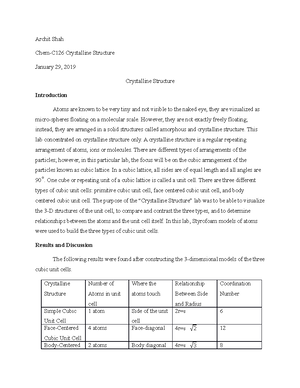

Experimental Chemistry II
Coursework
Experimental Chemistry II
Coursework
Experimental Chemistry II
Coursework
Experimental Chemistry II
Coursework
Experimental Chemistry II
CourseworkNethercutt Jenna 12/10/ Chem C
Introduction Electrochemistry is an area of chemistry that explores oxidation-reduction reactions. This is typically done through the use of electricity to drive a nonspontaneous reaction or through the production of electricity using a spontaneous reaction. Electrical energy is utilized in electrolytic cells in order to bring about a chemical change. Redox reactions occur when electrons are transferred from one substance to another. The substance that loses electrons is oxidized while the substance that gains electrons is reduced. Simple redox reactions involve metals that have different tendencies to be oxidized and different metals that have different tendencies to be reduced. In order to determine where the oxidation and reduction has occurred in a chemical reaction, redox reactions can be divided into two half-reactions. Electricity is produced by a spontaneous reaction that occurs in a voltaic cell; this allows for the separation of the two half reactions and the flow of electrons can be tapped into. A typical voltaic cell allows for electrons to flow through an external circuit and the metal strips are connected by wires that are attached to a voltmeter (which allows the cell voltage to be measured). Salt bridges, consisting of potassium nitrate embedded into gelatinous agar, is used to electrically connect the two half-cells and to allow electrical neutrality to be maintained. The calculation of the half-cell reduction potential can be done through measuring the spontaneous reaction of pairs of metals and metal ions. The purpose of the experiment was to determine the reduction of half-cell potentials for nickel and zinc given the half cell potential value for copper. The free energy at various temperatures measured in this experiment were used to calculate the enthalpy and entropy of the nickel and copper redox reaction. The copper/nickel cell was placed in a water bath that was heated to an initial temperature of 348 K and the Ecell was recorded.
Results and Discussion The initial cell potentials that were measured at the beginning of the experiment for the copper/zinc cell, copper/nickel cell, and zinc/nickel cell were 1 V, 0 V, and 0 V respectively. Using these cell potentials and the given reduction half cell potential of copper (0 V), the reduction half cell potentials of zinc and nickel. The reduction half cell potential for zinc was -0 V while the reduction half cell potential for nickel was -0 V. The copper/nickel cell with the initial temperature of 348 K had a measured Ecell of 0 V and ΔGrxn of -19 kJ. At 338 K and 328 K, the measured Ecell’s were 0 V and 0 V with calculated ΔGrxn’s of -15 kJ and -11 kJ respectively. When the temperature was 318 K, the Ecell was 0 V and its ΔGrxn was -9 kJ and when the temperature was 308 K, the
Ecell was 0 V and the ΔGrxn was -8 kJ. The final Ecell values were recorded at 298 K and 288 K, and were 0 V with a ΔGrxn of -6 kJ and 0 V with a ΔGrxn of -5 kJ respectively. Once this data was graphed, the best-fit line equation was y = -0 + 69, where the slope was -0 and the y-intercept was 69. The slope of the equation is equal to -ΔSrxn, which means that the ΔSrxn of the reaction was 0 J/K. The y-intercept of the equation is equal to ΔHrxn, meaning that the ΔHrxn equals 69 kJ. An alternative determination of ΔHrxn at room temperature was found to equal 68 kJ, which is relatively close to the ΔHrxn that was calculated from the best-fit line equation. The correlation coefficient of the equation was found to be 0, indicating that there was a relatively significant correlation between the two sets of data.
Conclusion The results of this experiment depict a correlation between ΔGrxn and temperature (in Kelvin). As the ΔGrxn of the copper/nickel cell increased, the temperature of the cell decreased, meaning that the ΔSrxn and ΔHrxn are positive. When enthalpy and entropy are both positive, this indicates that the reaction is endothermic and dependent on temperature: as the temperature increases, ΔGrxn will become more negative and the reaction will become favored. Electrochemistry has been utilized in many common applications that are used in everyday life. For instance, batteries are electrochemical cells that produce an electric current and rely on chemical reactions in order to generate electricity. Cell phones, digital cameras, hearing aids, and digital watches are just some examples of how batteries are used constantly throughout one’s daily life. Without batteries (and electrochemistry), chemical energy would not be able to be harnessed as a form of electrical energy that is easily utilized as an efficient source of nearly unlimited energy.